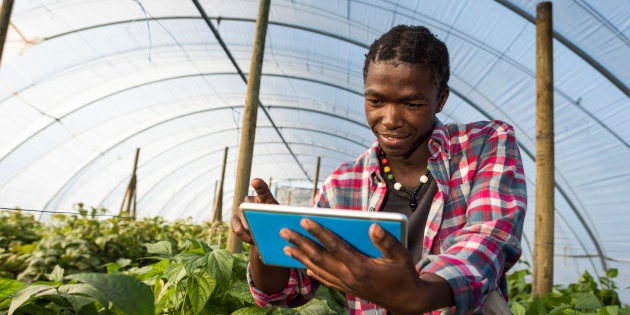
In the life of any nation there exist decisions upon which its future depends. Recognising that there is a time to gather stones and a time to scatter them can be the turning point. The nations on the African continent may be portrayed in the annals of history as engaged in a cyclical struggle; a struggle for political power, a struggle for peace, for stability, even for food. No doubt some of these are viewed through a colonial lens, ignoring the triumphs which emerge from such struggles. Yet many are real.
And whilst Africa's actual and potential prosperity is overlooked, one remaining crisis should not be: the unprecedented infrastructure crisis around the provision of power to homes, businesses, hospitals and schools. Only seven countries in Africa currently have electricity access rates that exceed 50 percent and there are currently 625 million people living outside the reach of traditional distribution grids. The correlation between electricity supply and economic growth is irrefutable. No government can stand a chance of adequately growing its GDP, or indeed sharing the proceeds of this growth, if power distribution reaches less than half of its population. If ever there was a time to gather together, it is now.
The provision of power to a population is not simply an economic conversation, but rather a humanitarian one. For most, electrification does not mean running a refrigerator or television but providing heat and light from a source that does not fill a home with dangerous fumes, or charging a cell phone from which payments can be made, phone calls received and even news reports read. Providing electricity to homes means healthier families, better educated children and optimising financial inclusion to capture those in rural areas. The provision of power to a population is not simply an economic conversation, but rather a humanitarian one.
The stumbling block to reaching a resolution to these issues on our continent consists in seeking solutions which are grandiose and costly; which are not bespoke to the particularities and the constraints of African problems. They are solutions inherited from elsewhere in the world; befit only for energy provision elsewhere in the world. Efforts to address the electricity crisis have foundered on delays in funding, the practicality of construction and any perceived environmental impact. At the highest levels of discussion, massive generation projects like hydroelectric plants have been proposed, at the more modest end of the scale we have discussions around fuel-efficient cookstoves and solar lamps. Each has either been too lofty or too modest in its ambitions and real progress has remained our scarcest commodity.
Now Africa faces a fork in the road: either committing to the well-trodden but impractical road of centralised electricity generation, or carving a new and pioneering path towards alternative energy solutions. It is in this latter option that I believe we can truly change the fortunes of our continent. For all the problems that infrastructure deficiencies have presented to Africa, it is in many ways a mixed blessing. Countries around the developed world are themselves hesitantly exploring options for transitioning towards a carbon constrained future, but each faces the enormous hurdle presented by replacing or adapting the legacy infrastructure upon which their power provision relies.
Africa, for the most part, has no such problem, precisely because in many instances it is a case of creating new infrastructure, rather than replacing existing systems. We are creating, building and innovating; rather than replacing, repairing and renovating. In the same way we have leapfrogged legacy banking systems with mobile payments, we are in a position to do the same with renewable energy. By 2020, just 20 percent of people in Africa will own a traditional bank account whilst 80 percent will own a smart phone. On this continent, resourcefulness is second only to adaptability.
I believe the real opportunity for Africa is to demonstrate to the world the impact of small-scale, blended renewable energy sources at a micro-grid and mobile level.
The challenge we are faced with, therefore, is to summon the will to meet our energy challenges with the most pioneering solutions. The struggle for energy across Africa is not comparable with other nations, therefore we should not be constrained to the solutions sought by such other nations. We should favour sustainable solutions over imitating the outdated modes of generation which will become a future burden. And we should favour more agile micro-level modes of generation which can meet our needs in months, over behemoth projects which will take generations for their effects to be felt.
I believe the real opportunity for Africa is to demonstrate to the world the impact of small-scale, blended renewable energy sources at a micro-grid and mobile level. So consider this: the DRC is currently poised to begin construction on the largest hydroelectric dam in the world. Supporters say that it will produce electricity equal to 20 large nuclear power stations. Critics say it will displace 100,000 people and wreck the ecosystem. I say it's the right idea, but the wrong execution, and I welcome the discussion it has sparked. Africa's problems will not be solved by a reliance on massive, load-bearing generation plants. They take a long time to bring on-grid, cost an astonishing amount of money to construct and rarely benefit the rural and hard-to-reach communities that need them the most.
Many still regard off-grid power provision as a stop-gap measure, designed to bridge the gap until on-grid electrification has been achieved. But with on-grid development moving at a glacial pace, I believe the real opportunity for Africa is to demonstrate to the world the impact of small-scale, blended renewable energy sources at a micro-grid and mobile level. There is no reason, for instance, that the DRC's Grand Inga Dam could not work as micro hydro systems, bringing immediate benefits at both micro and macro levels of power generation. Equally, the DRC enjoys 1,739 hours of sunlight every year, Nigeria enjoys 1,885. On the other side of the continent, Sudan clocks in 3,814 sunny days. The cost of solar panels for generation and battery units for storage is reducing all the time.
The technology for creating micro-grids (which is to say a series of houses or businesses attached to a small generation source off or at the edge of the grid) is becoming easier to implement and more reliable to run. Hours of sunlight power homes in the day, efficient storage of the excess provides electricity in the night. What's more, solar photovoltaic system (Solar PV) kits are now as cheap as kerosene as a source of energy. With the availability of microloans and the popularity of the village-banking model of microfinance, the reality is that almost all Africans could have access to clean, abundant and virtually-free electricity within the next decade.
The supplementary bonus here is that countries, villages, even individuals, can grow their economies immediately without the time and expense of permanent generating capacity. And what's more, the regional transmission opportunities at the edge of the grid mean more immediate opportunities for brighter nations to export clean energy to gloomier ones. This week, the African Development Bank has announced a new electrification programme that will invest $12bn over the next five years. For the sake of our collective future, I implore the focus of those funds not simply to slide towards huge, load-bearing generation projects, but to look to widespread, more agile renewable sources at the micro-level. Doing so would be the last non-political power struggle Africa has to contend with and a gift to generations to come.
